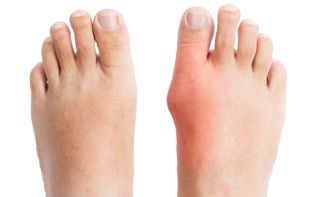0
item(s)
Cart is empty
|
Home
::
|
Gout

Gout is one of the most common and complex forms of arthritis and it has been found to that gout can affect anyone. The signs and symptoms of gout include sudden, severe attack of pain, swelling, redness, and tenderness in the joints, usually at the joint located underneath the big toe.
Suddenly a gout attack may occur; usually, you wake up in the middle of the night with the feeling that your big toe is on fire. The joints that are affected will be hot, swollen and so tender that even the weight of the sheet on it may seem unbearable.
Gout attacks can occur quickly and continue to reoccur as time goes on, slowly damaging the tissue in the area of inflammation. It is also associated with an increased incidence of cardiovascular and metabolic diseases and sometimes, it can be extremely painful.
In males, gout is generally known as the most common form of inflammatory arthritis, and although it is more likely to affect men, it can only affect women after menopause.
Causes of Gout
Uric acid is a waste product which is produced during the normal breakdown of purines. According to the NIAMS, purines are naturally occurring substances which can be found in foods such as liver, mushrooms, anchovies, mackerel, and dried beans.
The kidney helps to evacuate uric acid from the body, and it is passed out of the body together with urine. However, high levels of uric acid may accumulate in the body, and can either be as a result of the kidney excreting too little uric acid or when too much of uric acid is produced by the body. This condition is referred to as hyperuricemia, according to NIH.
High blood uric acid concentrations will eventually convert the acid to urate crystals, which have been found to accumulate around joints and soft tissues. When the needle-like urate crystals are deposited, it leads to inflammation and painful symptoms of gout.
According to NIH, several factors can make a person more vulnerable to gout. Some are:
• Have a family history of gout
• Obesity
• You have kidney problems
• Exposure to lead
• Drink too much alcohol
• Take certain medicines such as diuretics or niacin
Although gout may be painful in itself, it is also associated with other conditions such as cardiovascular disease, hypertension, diabetes, and kidney disease.
Symptoms of Gout
The signs and symptoms of gout almost always come suddenly and usually appear at night. They include:
1. Intense pain in the joints. The effect of gouts appears on the large joint of the big toe, at the same time, it can affect any other joints. Other joints that are commonly affected by gouts include ankles, knees, elbows, wrists, and fingers. The pains will probably be more serious within four to twelve hours after it occurs.
2. Persistent discomfort. When the most difficult pain disappears, some joint discomfort may last from several days to several weeks. Subsequent attacks can take longer and affect other joints.
3. Inflammation and redness. Affected joints or joints become tender, inflamed, warm and red.
4. Restricted movement. It will be difficult to move your joints normally as gout develops.
Gout Treatment
Treatment for Jumper's Knee requires restoring the circulation and blood flow to the affected structures in your affected. Pain is caused when swelling, inflammation and decreased circulation generate a blockage, which causes blood flow to be interrupted or slowed. Treatment for this issue requires breaking up the accumulated fluids in your affected area to allow for improved healing and quicker recovery.
Products recommended for symptoms of swelling, redness, pain, and inflammation, and if coolness makes your pain feel better:
Ice Substitute Poultice
Bruise Relief Liniment
Muscle Therapy Massage Oil
Products recommended when swelling and inflammation are gone, but you still feel pain, stiffness, weakness, and/or sensitivity in cold and damp weather, and if heat makes your pain feel better:
Pain Relief Liniment
Tendon and Ligament Poultice
Muscle Therapy Massage Oil
